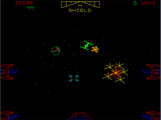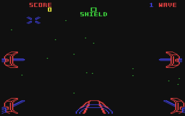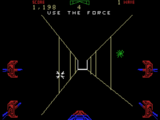Star Wars: The Arcade Game
- "Now coin video game players can plunge head-on into the world of LUKE SKYWALKER in the ultimate fantasy...STAR WARS!"
- ―Flyer advertising the arcade game
Star Wars: The Arcade Game, or simply Star Wars, is an arcade game produced by Atari and released on May 5, 1983.[1] The game is a first-person space simulator, based around Star Wars: Episode IV A New Hope. More specifically the game's action covers the Battle of Yavin. The game is composed of 3D color vector graphics. Considered one of the most popular video games of all time, it was greatly successful in its day, particularly in the wake of the theatrical release of Return of the Jedi.
It was later produced as Star Wars: The Arcade Game for the Atari 2600, Atari 5200, Atari 8-bit home computers, ColecoVision, and Commodore 64. In 1991, an updated version of the game was released for the NEC PC-98 and the Sharp X68000 systems under the title Star Wars: Attack on the Death Star. This version featured a long introductory cutscene at the beginning of the game.
Opening crawl
| ||
Gameplay
The player assumes the role of Luke Skywalker ("Red Five"), as he pilots an X-wing fighter from a first-person perspective. Unlike other arcade games of similar nature, the player does not have to destroy every enemy in order to advance through the game; he must simply survive as his fighter flies through the level, which most often means he must avoid or destroy the shots that enemies fire.
The player's ultimate goal is to destroy the Death Star through three attack phases.
- In the first phase of the game, the player begins in the airspace above the Death Star. He must engage in a dog fight with Darth Vader and enemy TIE Fighters.
- In the second phase, the player reaches the Death Star's surface as laser turrets on towers rise to confront the player. If the player manages to destroy all of the towers, he will receive a sizable point bonus.
- In the third phase, the player flies through the final trench towards the thermal exhaust port, the Death Star's weakness. Along the way he must avoid laser shots and various catwalks that block the path. At the end of the trench, the player must fly low in order to fire a proton torpedo into the port. If successful, the Death Star explodes and the game immediately restarts at a higher difficulty level. If unsuccessful, the player must restart the third phase from the beginning.
Each successive Death Star run greatly increases the difficulty; TIE Fighters shoot more often, there are more Laser towers and batteries in the second round, and there are many more obstacles and laser fire during the trench run. Unlike the movie, where the units shoot laser cannons, the enemy units in this game shoot projectiles resembling fireballs, in order to give the player a chance to destroy the shots fired at him.
Arcade details
The game featured several digitized samples of voices from the movie, including Mark Hamill as Luke Skywalker, Alec Guinness as Obi-Wan Kenobi, James Earl Jones as Darth Vader, Harrison Ford as Han Solo, and the mechanized beeps of R2-D2. The game was the first to feature digitized voice capabilities, often considered a prime factor of the game's success.
The game is available as a standard upright or an elaborately decorated sit-down version. The controls consist of a yoke control (similar to a steering wheel) with several buttons, all which fired the fighter's laser.
In some gameplay, the first level utilized The Imperial March. This was because the Arcade Game was released shortly after the release of Star Wars: Episode V The Empire Strikes Back.
Notes
- The game was developed during the Golden Age of Arcade Games and is considered the #4 most popular game of all time according to Killer List of Videogames.
- This game can be converted into The Empire Strikes Back arcade game.
Ports
The game was published for home computers in Europe by Domark in 1987. That same year Broderbund acquired the rights to develop Star Wars games from Lucasfilm. The Macintosh and Amiga versions of the arcade game were ported by Juergen Friedrich and published in North America by Broderbund in 1989. The Commodore 64 version was programmed by Daniel James Gallagher and featured voice sampling by Andy Beverage. Two versions were released for the Atari 5200 by Parker Brothers; Star Wars Arcade and Death Star Battle. The latter is almost an exact conversion of the Atari 2600 version, in Star Wars: Rogue Squadron III: Rebel Strike all 3 classic trilogy arcade games are unlockable (although ROTJ requires a cheat to unlock). The appearance of the arcade system in Rebel Strike indicated that the version used was the upright version of the arcade cabinet, and not the sit down model.
Media
Screenshot gallery
-
Original arcade version
Cover gallery
-
Atari 5200 box cover
-
Commodore 64 box cover (1984)
-
Commodore 64 box cover (1987)
Behind the scenes
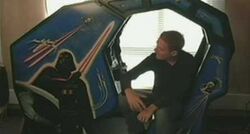
Joe Booth is credited as one of the game's programmers while John Cassells was the one responsible for the graphics. The game was programmed for the Atari 2600 by Bob Smith, who was involved in programming many other games for Atari. Mike Hally was the game designer.[source?]
Players with attention to detail may notice that after the TIE Fighter waves, when you are flying towards the Death Star, the yellow grid lines on the Death Star spell out either "MAY THE FORCE BE WITH YOU" on odd-numbered waves. Assorted peoples' names are spelled out on even numbered waves. When flying in the trench towards the vulnerable exhaust port, "USE THE FORCE" is spelled in green until you fire a shot. If you dodge the fireballs, do not fire any shots and use one shot to fire your torpedoes in to the exhaust port, you get a sizable "USE THE FORCE" bonus. This is encouraged by Obi Wan himself at the beginning of the trench sequence.
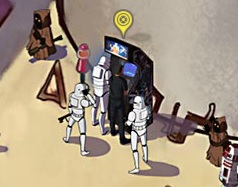
Concepts original to the game, most notably the Meridian trench being loaded with obstacles instead of barren as in the original film, were later reused for the Battle of Yavin mission in the 2001 game Star Wars: Rogue Squadron II: Rogue Leader, as well as its co-op port in Star Wars: Rogue Squadron III: Rebel Strike. The latter game also included the arcade game as an unlockable bonus. According to the making of documentary for Rebel Strike, the arcade game acted as the inspiration of the Rogue Squadron series.
The 2012 non-canon web-based video game Star Wars Galactic Spy included the arcade cabinet as one of the items players can search for in Mos Eisley. Stormtroopers are seen waiting for their turn to play the game.
In the films Gremlins and No Small Affair (both released 1984), both cabinets were depicted. The trench sequence was seen in Gremlins when the Gremlins play the game and in the film No Small Affair, an upright cabinet is used.
Appearances
| Characters | Creatures | Droid models | Events | Locations |
| Organizations and titles | Sentient species | Vehicles and vessels | Weapons and technology | Miscellanea |
Characters
|
Events
Locations
|
Organizations and titles
Vehicles and vessels
Weapons and technology
Miscellanea
|
Sources
 "Raiders Of The Lost Arcade" – Star Wars Galaxy Collector 7
"Raiders Of The Lost Arcade" – Star Wars Galaxy Collector 7 "Rebel Pilot Reunion" – Star Wars Insider 32
"Rebel Pilot Reunion" – Star Wars Insider 32 The Best Star Wars Games of the Atari Generation on StarWars.com (backup link not verified!)
The Best Star Wars Games of the Atari Generation on StarWars.com (backup link not verified!)
Notes and references
- ↑ 1.0 1.1 "Star wars." (Registration number: PA0000428109) (1988-11-30). United States Copyright Office (archived from the original on March 20, 2022)
External links
- Advertising flyer. Atari, 1983. (web archive)
- Operators Manual. Atari, 1983. (web archive)
- Cockpit Operators Manual. Atari, 1983. (web archive)
- Atari 5200 manual. Parker Brothers, 1984. (web archive)
 Star Wars on MobyGames
Star Wars on MobyGames - Star Wars. Killer List of Videogames (archived from the original on September 24, 2019)
- Star Wars. Arcade History Database (archived from the original on September 17, 2021)

